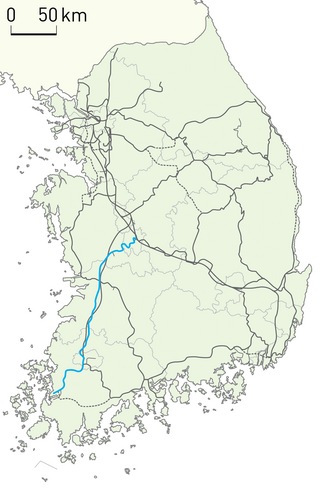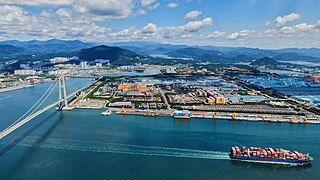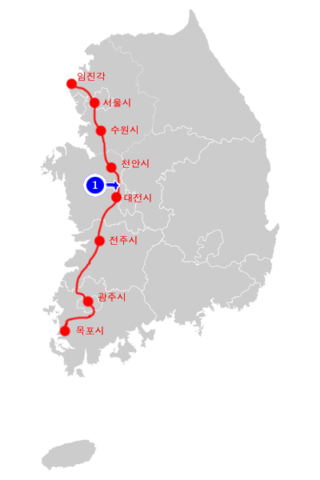
South Jeolla Province, also known as Jeonnam (전남), is a province in the Honam region, South Korea, and the southernmost province in mainland Korea. South Jeolla borders the provinces of North Jeolla to the north, South Gyeongsang to the northeast, and Jeju to the southwest in the Korea Strait.

Iksan is a city and major railway junction in North Jeolla Province, South Korea.

Jeolla Province was one of the historical Eight Provinces of Korea during the Kingdom of Joseon in southwestern Korea. It consisted of the modern South Korean provinces of North Jeolla, South Jeolla and Gwangju Metropolitan City as well as Jeju Province. The provincial capital was Jeonju, the current capital of North Jeolla. The entire inland region was called Honam, which is still commonly used today.

The Honam Line is a major railway line serving the Honam region in South Korea. The line is served by frequent passenger trains from Seoul to Gwangju and Mokpo.

Gwangyang is a city in South Jeolla Province, South Korea. Gwangyang is the home of POSCO's Gwangyang Steel Works, the largest facility of its kind in the world. The city is also home to K League Classic football side Jeonnam Dragons.

Haenam (Haenam-gun) is a county in South Jeolla Province, South Korea. The capital of Haenam-gun is Haenam-eup.

Muan County is a county in South Jeolla Province, South Korea. In 2005, Muan County became the capital of South Jeolla following the transfer of the provincial office from its previous location in Gwangju to the village of Namak in Muan. Muan International Airport was opened here and will eventually replace the airport in Gwangju.
Namak-ri is a village in the township of Samhyang-myeon in Muan County, South Jeolla province of South Korea. In 2005, Namak was made capital of the province following the upgrade of Gwangju to a metropolitan city.

Asiana Airlines Flight 733 was a domestic Asiana Airlines passenger flight from Seoul-Gimpo International Airport to Mokpo Airport, South Korea. The Boeing 737 crashed on 26 July 1993, in the Hwawon area of Haenam County, South Jeolla Province. The cause of the accident was determined to be pilot error leading to controlled flight into terrain. 68 of the 116 passengers and crew on board were killed. The crash resulted in the first hull loss of a 737-500.

Muan International Airport is an international airport in Muan County, South Jeolla Province, South Korea. Construction of the airport began in 1997, and the airport opened on 9 November 2007. The airport serves the province of South Jeolla, especially the cities of Gwangju, Mokpo, and Naju. It replaced the nearby Mokpo Airport, and is expected to replace the nearby Gwangju Airport as well. In 2018, 543,247 passengers used the airport. The airport is managed by Korea Airports Corporation.

The 2015 Summer Universiade was a Universiade held in the city of Gwangju, South Korea. It took place from July 3 to July 14, 2015. Gwangju also hostes the group matches of the 2002 FIFA World Cup.

National Route 1(Korean: 국도 제1호선; RR: Gukdo Je Il Hoseon) is a national highway in South Korea. It connects Mokpo, South Jeolla Province with the city of Paju in Gyeonggi-do. Before the division of the Korean peninsula, the highway ran until Sinuiju, North P'yongan Province, in present-day North Korea.
Hadang (Korean: 하당신도시) is the newly built urban area in Mokpo, South Jeolla Province, South Korea, which aims at accommodating increased population near Muan International Airport and movement of the provincial office. Before announcement of the transfer of office, Mokpo initially intended to rebuild another area for housing. The project was finalized so until 1999 most of area was leased for marketing, business, housing, and preliminary purpose.
Bohae is a South Korean brewing company based in Mokpo, South Jeolla Province, representing breweries company within Honam region. Among other beverages, Bonae produces soju and lemon cap, a wine made from Rubus coreanus.
High-speed rail service in South Korea began with the construction of a high-speed line from Seoul to Busan in 1992, and was inspired by Japan's Shinkansen. The first commercial high-speed rail service was launched on 1 April 2004. Currently, South Korea hosts two high-speed rail operators: Korea Train eXpress (KTX) and Super Rapid Train (SRT).
Han Seok-Hee is a professional footballer from South Korea who plays as an attacker, as of 2020 he plays for FC Mokpo.

Mokpo (Korean: 목포시) is a constituency of the National Assembly of South Korea. The constituency consists of the entirety of Mokpo city. As of 2020, 189,615 eligible voters were registered in the constituency. The constituency was created in 2000 from the Mokpo–Sinan A and Mokpo–Sinan B constituencies.

Jeju Air Flight 2216 was a scheduled international passenger flight operated by Jeju Air from Suvarnabhumi Airport in Bangkok, Thailand, to Muan International Airport in Muan County, South Korea. On 29 December 2024, the Boeing 737-800 operating the flight apparently suffered a bird strike. The pilots issued a mayday alert, performed a go-around, and on the second landing attempt, the landing gear did not deploy and the airplane belly landed well beyond the normal touchdown zone. It overran the runway and crashed into a berm encasing a concrete structure that supported an antenna array for the instrument landing system. The collision killed all 175 passengers and 4 of 6 crew members. The surviving 2 cabin crew were seated in the rear of the plane, which detached from the fuselage, and were rescued with injuries.












































